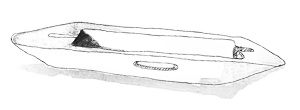
Weaving Yarn - Linen
Linen is a strong natural fibre from the cellulose family. It is a bast fibre, meaning it comes from long fibrous strands of the stem of a plant, in this case flax. Linen is highly favoured for high strength, coolness, moisture wicking and a soft handle that only gets better as it ages.
Napoleon, concerned about the French linen industry, offered 1,000,000 francs to whoever could modernise flax production. Before this, as all labour was done by hand up as machines were not yet invented that could process, spin and weave linen without it breaking. This is because the strength of linen makes it very inelastic. The industry joined the industrial revolution only four years after Napoleon’s offer, with the advent of wet spinning and weaving in especially designed machines.
Traditionally, linen is harvested and then ‘retted’, either in a damp field or a water source such as a pond or stream. This process can take anywhere from 14 to 28 days, and is crucial if the lignin that binds the bast fibers to the outer core is to be broken down enough for processing.
The invention of a purpose built retting tank, inspired by the steam engine, cut this down from a month to a maximum of 8 days.
Linen is a versatile and sustainable fiber choice for strength, durability and longevity, whether used as warp for a rug or tapestry, loose garments and interior furnishings or bags and napkins. It can be plied together to create strong rope, braid and twine. Linen yarns and garments should be washed in a lukewarm or 40 degree water and hung to dry so as to let the fabric crease naturally. It can be ironed at a hot temperature, and pre-washing/wet finishing before sewing is recommended.











